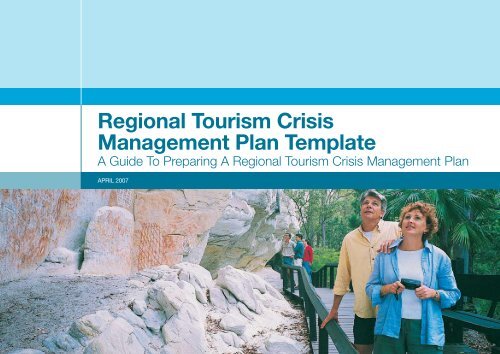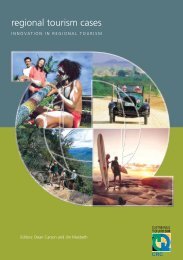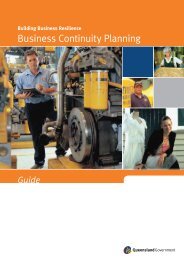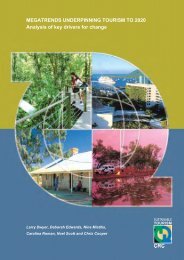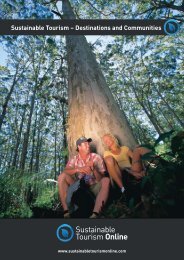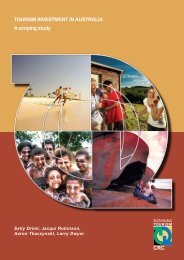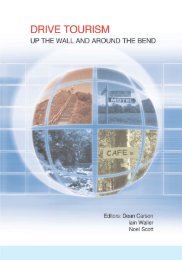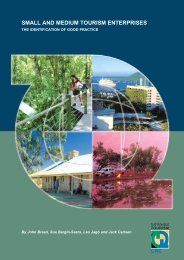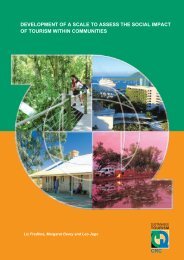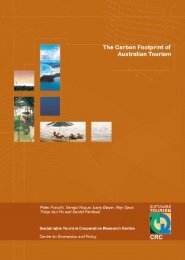Regional Tourism Crisis Management Plan Template - Sustainable ...
Regional Tourism Crisis Management Plan Template - Sustainable ...
Regional Tourism Crisis Management Plan Template - Sustainable ...
- No tags were found...
Create successful ePaper yourself
Turn your PDF publications into a flip-book with our unique Google optimized e-Paper software.
<strong>Regional</strong> <strong>Tourism</strong> <strong>Crisis</strong><strong>Management</strong> <strong>Plan</strong> <strong>Template</strong>A Guide To Preparing A <strong>Regional</strong> <strong>Tourism</strong> <strong>Crisis</strong> <strong>Management</strong> <strong>Plan</strong>APRIL 2007
0Section <strong>Regional</strong> <strong>Tourism</strong> <strong>Crisis</strong> <strong>Management</strong> <strong>Plan</strong> <strong>Template</strong> – April 2007
ContentsREGIONAL TOURISM CRISIS MANAGEMENT PLAN (R-TCMP) TEMPLATE.. . . . . . . . . 41 INTRODUCTION.. . . . . . . . . . . . . . . . . . . . . . . . . . . . . . . . . . . . . . . . . . . . . . . . . . . . . . 42 STEPS IN PREPARING YOUR PLAN.. . . . . . . . . . . . . . . . . . . . . . . . . . . . . . . . . . . . . . . 52.1 Consultation.. . . . . . . . . . . . . . . . . . . . . . . . . . . . . . . . . . . . . . . . . . . . . . . . . . . . . 52.2 Purpose.. . . . . . . . . . . . . . . . . . . . . . . . . . . . . . . . . . . . . . . . . . . . . . . . . . . . . . . . 62.3 Scope .. . . . . . . . . . . . . . . . . . . . . . . . . . . . . . . . . . . . . . . . . . . . . . . . . . . . . . . . . 62.4 Context .. . . . . . . . . . . . . . . . . . . . . . . . . . . . . . . . . . . . . . . . . . . . . . . . . . . . . . . . 72.5 Response and recovery initiatives.. . . . . . . . . . . . . . . . . . . . . . . . . . . . . . . . . . . . . 73 ACTIVATION.. . . . . . . . . . . . . . . . . . . . . . . . . . . . . . . . . . . . . . . . . . . . . . . . . . . . . . . . . 84 DEACTIVATION.. . . . . . . . . . . . . . . . . . . . . . . . . . . . . . . . . . . . . . . . . . . . . . . . . . . . . . . 95 MAINTENANCE. . . . . . . . . . . . . . . . . . . . . . . . . . . . . . . . . . . . . . . . . . . . . . . . . . . . . . . 9APPENDICES.. . . . . . . . . . . . . . . . . . . . . . . . . . . . . . . . . . . . . . . . . . . . . . . . . . . . . . . . . . . 10ContentsAppendix 1: Cyclone Larry Response and Recovery <strong>Plan</strong> Summary.. . . . . . . . . . . . . . . . . . 11Appendix 2: Purpose of <strong>Crisis</strong> <strong>Management</strong> <strong>Plan</strong>s .. . . . . . . . . . . . . . . . . . . . . . . . . . . . . . . 12Appendix 3: <strong>Crisis</strong> Communication <strong>Plan</strong> Checklist. . . . . . . . . . . . . . . . . . . . . . . . . . . . . . . . 13Appendix 4: Example <strong>Regional</strong> <strong>Crisis</strong> <strong>Management</strong> <strong>Plan</strong> Contact List.. . . . . . . . . . . . . . . . . 14Appendix 5: Example Action <strong>Plan</strong> – Response and Recovery Initiatives. . . . . . . . . . . . . . . . 15Appendix 6: Example Process Checklist.. . . . . . . . . . . . . . . . . . . . . . . . . . . . . . . . . . . . . . . 25Appendix 7: Example Scenario planning.. . . . . . . . . . . . . . . . . . . . . . . . . . . . . . . . . . . . . . . 26Appendix 8: Q-TCMP flow chart.. . . . . . . . . . . . . . . . . . . . . . . . . . . . . . . . . . . . . . . . . . . . . 30
Introduction1<strong>Regional</strong> <strong>Tourism</strong> <strong>Crisis</strong> <strong>Management</strong> <strong>Plan</strong>(R-TCMP) <strong>Template</strong>1 IntroductionWhy have a <strong>Regional</strong> <strong>Tourism</strong> <strong>Crisis</strong> <strong>Management</strong> <strong>Plan</strong> (R-TCMP)?A R-TCMP aims to ensure a consistent and coordinated approach to response andrecovery activities within the region, and between state and regional tourism bodies, inthe event of a ‘shock’ impacting tourism in a region.This template outlines the structure and content of a R-TCMP and the steps to takein preparing a plan. Also outlined is the scope of a regional plan versus the state plan(ie the Queensland <strong>Tourism</strong> <strong>Crisis</strong> <strong>Management</strong> <strong>Plan</strong> to assist in understanding thesituations requiring regional crisis management plan activation and where joint activityis relevant.The template is based on the Queensland <strong>Tourism</strong> <strong>Crisis</strong> <strong>Management</strong> <strong>Plan</strong> (Q-TCMP).Following this template in the preparation of your R-TCMP will assist in achievingconsistency with the Q-TCMP. You are strongly encouraged to include additionalinformation and resources as appropriate for your region, including tools, checklistsand guidelines to assist in improving responsiveness to an event or incident. TheAppendices provide some examples.Did you know?<strong>Tourism</strong> is particularly prone to external shocks, which by their nature areunpredictable and need to be addressed through effective crisis managementprocesses. Across the tourism industry there are lots of opportunities for ‘risks’to turn into ‘disasters’ or an upheaval event. Issues such as security concerns,natural disasters and outbreaks of infectious diseases have a tremendous impacton the tourism industry. So do incidents as isolated as a bomb threat in an officebuilding in a regional centre, an oil spill in a harbour or on the reef, a mini tornadoin an outback town, a train derailment, or a drowning at a beach or on the reef.All of these ‘shocks’ will have an impact on regional tourism and will require aresponse from the <strong>Regional</strong> <strong>Tourism</strong> Organisation (RTO) and <strong>Tourism</strong> Queensland(TQ) to ensure the least possible disruption to tourism in the region. As such, crisismanagement and risk assessment has become, and will remain, a vital componentof the way all businesses operate within the tourism industry.It is essential that a network of crisis management plans are in place, from thenational to the regional/local and individual tourism operator level, to respondto unforeseen events that occur and to improve the speed and extent to whichbusinesses and regions recover from these incidents.At the regional level, RTOs play a key role in leading and coordinating responseand recovery initiatives in times of crises, in conjunction with TQ and otherorganisations. Having a plan in place enables RTOs to acknowledge and formalizethe various response and recovery activities in which they become involved intimes of crises. RTOs can also assist operators to be better prepared for suchcrises by encouraging them to have appropriate risk and crisis management plansin place for their business.Cyclone Larry proved a valuable exercise for the <strong>Tourism</strong> Tropical NorthQueensland (TTNQ) and Townsville Enterprise Limited (TEL) RTOs, demandingeffective coordination across government departments and a response plan fortourism alongside other industries impacted. For a summary of the Cyclone Larrytourism response activities see Appendix 1. <strong>Regional</strong> <strong>Tourism</strong> <strong>Crisis</strong> <strong>Management</strong> <strong>Plan</strong> <strong>Template</strong> – April 2007
2 Steps In Preparing Your <strong>Plan</strong>The following are the key steps to follow in developing your plan. While you may wishto add further steps, those included in this template are considered vital to achievingan effective response in the event of a crisis.2.1 ConsultationKey action: Identify key stakeholders and involve them in preparing your planHelpful hints for preparing this section:nnnnIdentify any crisis management plans already existing in your region.Identify the various government agencies, industry groups and others that will beimpacted or have some role in the event of a crisis in your region.Bring these organisations together to assist in preparing your <strong>Plan</strong>. This groupwill also be crucial in implementing your <strong>Plan</strong> and is likely to become the <strong>Regional</strong><strong>Tourism</strong> Immediate Response Group (RTIRG). To gain buy-in from the appropriateState Government Departments this may be undertaken in co-operation with the<strong>Regional</strong> Managers Coordination Network through the Destination Action Groupmeeting process.This group could involve representation from:• Your RTO staff• Your Local <strong>Tourism</strong> Organisations• Your Local Government authority• Your local and/or regional visitor information centres• Your TQ <strong>Regional</strong> Director and/or Coordinator• Local and regional representatives of key state government agencies (egDepartment of State Development, Department of Employment and IndustrialRelations, Environmental Protection Agency, Queensland Police Service,Department of Primary Industries and Fisheries, Department of NaturalResources & Water, Department of Emergency Services, Department of MainRoads etc)nnnnInvolvement from these people will:• bring new and varied ideas to the planning process;• improve understanding of your plan and its purpose;• help gain strong ownership of, and commitment to your plan;• enable a whole of government approach to effectively tap into Governmentrecovery efforts; and• ensure more effective implementation of your plan.Conduct a workshop with this group to discuss content (including undertakingregional scenario exercises) and prepare your plan.Once drafted, present your plan to your Board for final sign-off.Once finalised, distribute your plan to your RTIRG and other key stakeholdersinvolved in crisis management in your region. Promote its availability to youroperators.Did you know?The Q-TCMP was developed in close consultation with industry and governmentstakeholders. It incorporates feedback from the <strong>Tourism</strong> Assistance Hotline Survey(post September 11/Ansett collapse), TQ Managers, and the <strong>Tourism</strong> ImmediateResponse Group 1 . In addition, feedback was included from a series of workshopsheld involving TQ, Department of <strong>Tourism</strong>, Fair Trading and Wine IndustryDevelopment (DTFTWID) and the Queensland <strong>Tourism</strong> Industry Council’s (QTIC)Associations Council.1 The <strong>Tourism</strong> Immediate Response Group consists of Department of <strong>Tourism</strong>, Fair Trading, WineIndustry Development (DTFTWID), Department of State Development and Trade, Queensland RuralAdjustment Authority, Treasury/OESR, Department of Employment and Industrial Relations, Premiersand TQ.Steps in Preparing Youor <strong>Plan</strong>2
Steps in Preparing Youor <strong>Plan</strong>22.2 PurposeKey action: Identify the purpose of your <strong>Plan</strong>.Helpful hints for preparing this section:nThe purpose of your <strong>Plan</strong> could mirror the purpose of the Q-TCMP.Example:• To provide an integrated plan that will enable XXX (organisation name) to assistthe industry and individual operators reduce the impact of local and regionalshocks that result in a downturn in domestic and/or international travel in the short,medium or long-term.• To identify the key processes that can be initiated in the event of a significantregional crisis.Did you know?Appendix 2 provides some examples of <strong>Plan</strong> purposes.2.3 ScopeKey action: Identify what tourism crises your <strong>Plan</strong> will respond to.Helpful hints for preparing this section:nnOf the potential incidents that may impact tourism in your region, identify whatcrises will be covered by the <strong>Plan</strong>.The scope of your <strong>Plan</strong> could mirror the type of incidents within the scope of theQ-TCMP but at a regional/local level eg natural disaster impacting region, visitordeaths in region.Did you know?The Q-TCMP will respond to any potential tourism crisis that will have either adirect or indirect impact upon the industry. Examples of tourism industry crisesinclude:Direct:• tourism related industrial dispute/business collapse (eg. pilots strike, airlinecollapse)• natural disasters in tourism areas (eg. cyclones, flooding, bushfires, oil spills)• tourist deaths/injuries (eg. murders, Irukandji jellyfish stings, drownings, fires)• terrorism involving tourism infrastructure or touristsIndirect:• terrorist attacks/military activities (eg. September 11, Gulf War, Bali bombing)• unsustainable increases in public liability insurance (PLI)• economic downturn (eg. Asian financial crisis)• currency fluctuations• health scares (eg. Foot & Mouth Disease, SARS) <strong>Regional</strong> <strong>Tourism</strong> <strong>Crisis</strong> <strong>Management</strong> <strong>Plan</strong> <strong>Template</strong> – April 2007
2.4 ContextKey action: Establish links between your <strong>Plan</strong> and the Q-TCMP, other regional crisismanagement plans and local plans and processes in place.Helpful hints for preparing this section:nnnIdentify in your <strong>Regional</strong> <strong>Tourism</strong> <strong>Crisis</strong> <strong>Management</strong> <strong>Plan</strong> where it will link in withthe activity of the Q-TCMP.Obtain copies of any other regional and local crisis management plans for yourregion (tourism and other industries), including Department of Emergency Services’disaster management plans. Make a note of them in this section, and explain howthey link with and support your <strong>Plan</strong>.Include an organisation chart that shows the organisations that may be involved inthe event of a crisis. The RTO may work with these organisations in the event of amajor incident to devise and implement strategies.Did you know?To achieve consistency and coordination in response and recovery activities, theQ-TCMP directly links with the National <strong>Tourism</strong> Incident Response <strong>Plan</strong> (NTIRP).It is encouraged that any regional tourism crisis management plans and processeslink with the Q-TCMP. Also, every effort should be made for regional tourism crisismanagement plans to link with District/<strong>Regional</strong> and Local Disaster <strong>Management</strong>Groups established under the Disaster <strong>Management</strong> Act.<strong>Regional</strong> shocks that have a direct or indirect impact on the industry will involveactivation of both a regional crisis management plan and the Q-TCMP. If theshock has short term local or regional impacts, the Q-TCMP communicationstrategy will be activated. Escalation of the Q-TCMP beyond communicationactivities is dependent upon whether the shock is likely to reduce domestic and/orinternational travel to Queensland. A coordinated and consistent approachtherefore is of tremendous value to a region when faced with a crisis. The CycloneLarry Response and Recovery <strong>Plan</strong> Summary (see Appendix 1) provides a usefulexample of the interaction of the RTOs, TQ and other industry bodies during acrisis.2.5 Response and recovery initiativesKey action: Outline the range of response and recovery actions that will beundertaken in the event of a crisis (as defined by 2.3 Scope) to ensure the timelyrecovery of the tourism industry to at least pre-event activity levels.Helpful hints for preparing this section:nnnnnIdentify the key, generic responses that need to be undertaken, includingconvening your RTIRG and preparing a situation assessment.Include specific responses that will be undertaken in your region in the areas ofcommunication, research, marketing, business/industry development assistanceand product/infrastructure redevelopment. This may also include providing basicnecessities such as food, water and accommodation to residents and visitors toyour region.As communication is a critical activity during a crisis, it is highly recommended thata <strong>Regional</strong> <strong>Crisis</strong> Communication <strong>Plan</strong> be developed to guide your communicationactivities. See Appendix 3 for a <strong>Regional</strong> <strong>Crisis</strong> Communication <strong>Plan</strong> checklist toassist you in preparing this <strong>Plan</strong> for your region.As it may also be necessary for the RTO to become part of another agency’scommunication plan such as Police, Emergency Services and the State Disaster<strong>Management</strong> Group, it would be useful for your <strong>Plan</strong> to include the contact detailsof the key people and organisations. See Appendix 4 for a contact list example.Specify how you will work with other organisations (particularly TQ) in undertakingresponse activities, for example:• Communication: Implement <strong>Regional</strong> <strong>Crisis</strong> Communication <strong>Plan</strong>, in consultationwith TQ• Research: collect and collate information from operators about the impact of thecrisis on their business. Provide information to TQ for analysis (if requested).• Marketing: Prepare a marketing response plan for the region, in close collaborationwith TQ.• Business/industry assistance: Inform operators about availability of relief efforts,and ensure any assistance programs recognise the needs of tourism operators.Steps in Preparing Youor <strong>Plan</strong>2
Activation3nn• Product/infrastructure redevelopment: Work with TQ to identify and facilitateinfrastructure redevelopment needs and opportunities for the region (or partsthereof).Summarise the responses in an Action <strong>Plan</strong> that includes the action, keyindividuals and organisations responsible for undertaking each action, outcomesand timeframe for action (see Appendix 5).Develop checklists, protocols and guidelines to help in the effective managementof the issue or crisis and to minimise impacts (see Appendix 6 for checklistexample and Appendix 7 for scenario planning worksheets).Did you know?The Q-TCMP includes generic and specific response and recovery initiatives.Specific responses include:- Communication- Research/data collection- Marketing- Business/Industry development assistance- Product/Infrastructure redevelopment.Based on past application of the Q-TCMP, these categories have provenappropriate. The Product/Infrastructure redevelopment category was addedpost-Cyclone Larry as during the recovery activity this area of responsewas acknowledged as critical for the re-establishment of operators and thedestinations.When a crisis event hits a region, TQ will work with your organisation to assist inthe response and recovery activities. The Q-TCMP will be activated at the levelrelevant to the scale of the incident and action undertaken to support your effortson the ground in leading and coordinating local/regional response and recoveryinitiatives. Cyclone Larry provides a useful example of the role of RTOs and TQduring a crisis (see Appendix 1).3 ActivationKey action: Establish when your <strong>Plan</strong> will be activated and the type and scale ofresponse required.Helpful hints for preparing this section:nnnnOutline the activation levels required for your <strong>Plan</strong>, according to the severity andimpacts of crisis. It is recommended the activation levels reflect those outlined inthe Q-TCMP.Use a flow chart to illustrate the activation levels, the major response actions andkey stakeholders involved at each level. See Appendix 8 for a Q-TCMP flow chart.Clearly identify who will lead and who will coordinate activities at each level ofactivation and their roles and responsibilities. Have regularly maintained contactdetails for the people in these roles, and their alternates in the event they areunavailable.Your plan should note that in times of crises, RTOs would work closely with TQ todetermine the required level of activation of your plan and if and when to escalateto the next level. This will also ensure that your plan and the Q-TCMP reflect thesame level of activation at all times throughout the crisis response and recoveryprocess.Did you know?The Q-TCMP has three levels of activation:Level 1: events likely to have short term, local or regional impacts (eg visitoraccidents/deaths)Level 2: events likely to reduce domestic/international travel to Queensland in short,medium or long term (eg tourism related industrial disputes and terrorist activities).Level 3: events likely to have long-term consequences for the Queensland tourismindustry and operators (eg domestic terrorist activity; major shocks in combination– September 11 & Ansett demise).At each level of activation different stakeholder groups become involved, from TQCorporate Communications at level one, TQ/<strong>Tourism</strong> Strategy Division at level two,through to a cross-government response group at level three. <strong>Regional</strong> <strong>Tourism</strong> <strong>Crisis</strong> <strong>Management</strong> <strong>Plan</strong> <strong>Template</strong> – April 2007
4 DeactivationKey action: Identify when the <strong>Plan</strong> will be deactivated and how that decision will bereached.Helpful hints for preparing this section:nAssign responsibility for deactivating your <strong>Plan</strong> to an individual within your RTOor a group in your region. This role will vary depending on the level to whichthe <strong>Plan</strong> was activated. For example, Level 1 might be deactivated by the RTOCommunications Manager and/or GM or Chair of the Board, whilst Levels 2 and 3might be deactivated by your <strong>Regional</strong> <strong>Tourism</strong> Immediate Response Group.n Liaise with TQ prior to deactivating your <strong>Plan</strong>, to ensure consistency with the Q-TCMP deactivation process and timing.Did you know?The TQ <strong>Crisis</strong> Response Group assesses the situation and agrees when the Q-TCMP <strong>Plan</strong> should be deactivated.Deactivation does not mean stopping all activities associated with the <strong>Plan</strong>, but thepoint when a staged approach to winding down occurs.5 MaintenanceKey action: Put processes in place to ensure your <strong>Plan</strong> is regularly maintained,reviewed and updated.Helpful hints for preparing this section:nnnnAssign responsibility for maintaining your <strong>Plan</strong> to an individual within your RTO, andinclude this responsibility in their Position Description.Ensure that your <strong>Plan</strong> is reviewed at least annually to ensure accuracy andcurrency of its contents (particularly the contact list – see Appendix 4).Include a requirement for preparing and maintaining a <strong>Plan</strong> within your RTOBusiness <strong>Plan</strong> and Destination <strong>Management</strong> <strong>Plan</strong>.Include the key stakeholders involved in preparing this <strong>Plan</strong> (particularly yourRTIRG) in the review and update process. It is also a good opportunity to remindthem of the <strong>Plan</strong>’s contents.Did you know?The Q-TCMP is regularly updated to incorporate learnings from past crises and toensure all information is current.DeactivationMaintenance45
Appendices
Appendix 1:Cyclone Larry Response and Recovery<strong>Plan</strong> SummaryCyclone Larry crossed the Queensland Coast at 7:00am on 20 March 2006. Thecyclone was a Category 3/4 force with wind speeds of up to 280 km/h. The regionalcoastal city of Innisfail and towns within a corridor taking in communities from theSouth point of Kurramine Beach and North West across the Atherton Tablelands wereseverely affected. Major damage to tourism product and infrastructure was confinedto Kurramine Beach, Mission Beach, Dunk and Bedarra islands, Innisfail and townslocated on the Atherton Tablelands excluding Kuranda and Mareeba. Also internationaltourists were found to be in the cyclone zone without support.In response to the incident, TQ immediately activated the Queensland <strong>Tourism</strong> <strong>Crisis</strong><strong>Management</strong> <strong>Plan</strong> (Q-TCMP) and Cyclone Scenario <strong>Plan</strong>ning Summary. The Q-TCMPwas activated to level two, which involves <strong>Tourism</strong> Queensland/DTFTWID response toindustry and government on a wide range of issues related to the event. In partnershipwith QTIC, the relevant RTOs and key government agencies, actions were activated inthe areas of communications, marketing/PR, industry assistance and data collection/research.Industry Assistance:nnnAssistance program administrators were contacted to ensure that tourismoperators were adequately recognised in these programs.<strong>Tourism</strong> operators were regularly informed and updated about the availability ofthese programs through special <strong>Tourism</strong> on Q bulletin editions.Assistance was provided to QTIC to gain information on, and assist, the mostbadly affected operators.Research/Data Collection:nInformation was obtained from the RTOs and operators to model three scenarioson the estimated effect of Cyclone Larry on Northern Queensland regions.Marketing:nnMarketing Response <strong>Plan</strong>s for the Townsville and <strong>Tourism</strong> Tropical NorthQueensland regions were developed in consultation with the RTOs.A Treasury submission was prepared to lobby for additional funds to implement themarketing plans.Appendix Appencix 1Communications/PR:nnnA coordinated communications response between TQ, the RTOs and key industrybodies was developed and delivered to the media, operators and the community.An agreed communications message that focused on the region being ‘open forbusiness’, whilst being sensitive to the needs of badly affected operators and therelief efforts, was developed and delivered.Positive stories about unaffected or ‘open for business’ operators were obtainedand provided to the media.11
Appendix 2:Purpose of <strong>Crisis</strong> <strong>Management</strong> <strong>Plan</strong>sThe purpose of the Q-TCMP is to:nnprovide an integrated plan that will enable the Queensland Government to assistthe tourism industry and individual operators reduce, or respond to, the impacts ofshocks that result in a downturn in domestic and/or international travel in the short,medium or long-term.identify generic processes that can be initiated in a timely and effective mannerin the event of a significant shock. (Note: a generic approach is consideredappropriate, as specific shocks will always require additional unique responses).The <strong>Tourism</strong> Noosa Issues and <strong>Crisis</strong> Communications Manual notes that:Appendix 2“development of an effective Issues and <strong>Crisis</strong> Communications Manual is vitalto ensuring the destination can swiftly respond to serious issues or crises, devisestrategies to help retain confidence and minimise long terms impacts in the recoveryfrom significant events…. The manual is designed to assist TN effectively plan for,manage and assist recovery from a major incident.”The objective of the National <strong>Tourism</strong> Incident Response <strong>Plan</strong> (NTIRP) is:“to establish a framework to ensure national tourism incidents are managed in acoordinated whole of government way to minimise potential negative economicimpacts to the industry.”12 <strong>Regional</strong> <strong>Tourism</strong> <strong>Crisis</strong> <strong>Management</strong> <strong>Plan</strong> <strong>Template</strong> – April 2007
Appendix 3:<strong>Crisis</strong> Communication <strong>Plan</strong> ChecklistDefinition of a <strong>Crisis</strong>A serious event - perceived or real - that has the potential to impact negatively on thedesirability or reputation of a tourist destination or the reputation in the immediate toshort-term.Examples of a crisis:nnnnnnnDeath or injury of a visitor through an accident or deliberate actionThreats to the safety and well-being of visitors and the communityNatural (eg cyclones, fire, flood) and man-made disasters (eg pollution, violence,industrial action)Negative events that are likely to receive media attentionNegative commentary on international visitors and foreignersInternal issues such as death, injury or an incident involving staffA major political issue involving the organisation or industry.<strong>Crisis</strong> Communication PolicyThis section sets out the communication policy for the organisation and the proceduresfor managing a crisis.The policy should determine:nnnPosition responsibilities, who does what (i.e. media management and strategy,industry liaison and coordination, public enquiries management, issues andrisk management, grief management (if applicable), crisis management contactlistings).Information required regarding the crisis (i.e. what, when, where, who, why).Who needs to know and when (i.e. internal and external stakeholders).nnKey actions required and by when (i.e. Reports to key stakeholders and partnersincluding local, state and federal government authorities and ministers’ offices,media briefings, industry briefings, preparation of messages and PR material).Information dissemination as required.RecoveryThe following may be required in the recovery phase:nnnnnnnnnOngoing internal and external communicationMedia famils and post-incident media opportunitiesMarket researchTrade missions or VIP visits or familsExternal briefings or correspondence to industry, community or governmentstakeholdersCommunication of any regulatory or legislative changes/funding or relief programsMonitoring of any ongoing legal action/investigationsOngoing media management i.e. recovery milestones, anniversaries, good newsstories.Public acknowledgementsAppendix 313
Appendix 4: Example <strong>Regional</strong> <strong>Crisis</strong> <strong>Management</strong> <strong>Plan</strong> Contact ListInclude (and maintain) a contact list for all key stakeholders involved in the activation of your regional tourism crisis management plan, for example:Level 1 Activation – <strong>Regional</strong> <strong>Crisis</strong> Communication <strong>Plan</strong>Organisation Contact Contact DetailsRTOLevels 2 and 3 Activation – <strong>Regional</strong> <strong>Tourism</strong> Immediate Response GroupOrganisation Contact Contact DetailsAppendix 4Other ContactsOrganisation Contact Contact Details14 <strong>Regional</strong> <strong>Tourism</strong> <strong>Crisis</strong> <strong>Management</strong> <strong>Plan</strong> <strong>Template</strong> – April 2007
Appendix 5: Example Action <strong>Plan</strong> – Response and Recovery Initiatives1.0 CommunicationImpactActions/ResponsesResponsibility(lead agency in bold)OutcomesTimeframe for actions1.1 Reduction in domestic visitornumbers to regionImplement <strong>Regional</strong> <strong>Crisis</strong>Communication <strong>Plan</strong><strong>Crisis</strong> messages directed to themedia and public are developedwith consideration of the potentialimpact on the tourism industry,minimising potential negativeimpacts of the shock.Pre-Shock:- <strong>Plan</strong> developed and in placePost-Shock:- Utilise <strong>Plan</strong>(primarily short to medium-term)1.2 Reduction in internationalvisitor numbers to regionImplement <strong>Regional</strong> <strong>Crisis</strong>Communication <strong>Plan</strong>International visitors better able toaccurately differentiate betweenAustralian regions and determinewhat elements of a plannedholiday, if any, may be affected.reducing both uncertainty forinternational visitors and negativeimpacts on the industryPre-Shock:- <strong>Plan</strong> developed and in placePost-Shock:- Utilise <strong>Plan</strong>(primarily short to medium-term)Appendix 51.3 Uncertainty concerningaffected areas relative to travelplansProvide specific, accurate andtimely information to industry andconsumers (both domestic andinternational), including transportaccess restrictions, through RTOand LTO newsletters and websites,and through local and regionalvisitor information centresReduces uncertainty for domesticand international visitors andoperators, therefore minimisingthe potential negative impacts ofa shock on affected and nonaffectedareas.Pre-Shock:- RTO websites and newsletters inoperationPost-Shock:- RTO website accessed by industryand travellers(short to medium-term)1.4 Transport access restrictions:- Road, air, sea & railLiaise with relevant agencies toprovide up-to-date road, rail andsea access info in RTO and LTOnewsletters and websites, andthrough local and regional visitorinformation centresMinimised impact of transportaccess restrictions on internationaland domestic visitors, operatorsand regions.Post-Shock:- Liaise with relevant agencies andprovide transport info on website, innewsletters and through local VICs(primarily short-term)15
2.0 Research/Data CollectionImpactActions/ResponsesResponsibility(lead agency in bold)OutcomesTimeframe for actions2.1 Uncertainty regarding industryconditions in the post-shockperiodContact operators to canvas andmonitor potential/effects and togather market intelligenceRTO, TQ and industry betterinformed of industry conditions ,thus better able to make informeddecisions in the post-shock periodPost-shock:- Utilise existing networks & conductqualitative surveys as required(short to medium-term)2.2 Downturn in tourism industry,and the wider regional and/orState economyAssist TQ to undertake qualitativeassessment of day-to-day andmedium to long-term impacts ofshock.Stakeholders better informed ofimpacts to assist decision makingon appropriate response andrecovery actionsPre-shock:- Across government and tourismnetwork preparations based onpast experiencePost-Shock:Appendix 5- Appropriate support programs inplace16 <strong>Regional</strong> <strong>Tourism</strong> <strong>Crisis</strong> <strong>Management</strong> <strong>Plan</strong> <strong>Template</strong> – April 2007
3.0 MarketingImpactActions/ResponsesResponsibility(lead agency in bold)OutcomesTimeframe for actions3.1 A significant reduction ininternational visitation to theregionWork with TQ to apply MarketingResponse Framework to developresponse strategies:1. Collect Information/Intelligencen Identify affected marketsn Identify specific marketsegments affected (eg VFR/FIT/Corporate/Incentive)2. Interpret Information/Intelligencen Estimate short/medium/long-term impact on visitorarrivals/spend/average length of stay(ALOS) etc from affectedmarketsTimely and appropriateresponse strategies developed(including marketing campaignsand cooperative marketingopportunities), based on relevantmarket information & intelligence,with an emphasis on:n domestic travel and repeatvisitationn niche markets, andn identifying new markets… thus minimising the potentialnegative impacts of a reduction ininternational visitationPre-shock:- identify and establish information/market intelligence conduitsAppendix 5n Quantify/estimateconsequent economicimpact on region andaffected industry segmentsn Develop appropriateresponse strategies3. Communicate proposedresponse/s to industryn via RTO websites andnewsletters17
4.0 Business/Industry Development & AssistanceImpactActions/ResponsesResponsibility(lead agency in bold)OutcomesTimeframe for actions4.1 A reduction in domestic and/or international travel to theregion in the short, medium orlong-termnnProvide input to developmentof the Situation AssessmentReport (auspiced under theQ-TCMP)Assist in directing operatorsto the Government BusinessInformation Service (GOBiS,DSD) for access to up-todateinformation on availableState and Commonwealthgovernment supportprograms. Support servicesinclude:- Training, seminars &workshops- Government subsidies andgrants- Trade assistance anddevelopmentMinimised negative impacts of ashock in the post-shock periodPre-shock:- Across-government and industrynetwork preparations based onprevious experiencePost-shock:- Situation Assessment Reportproduced(primarily short-term)Appendix 54.2 Significant long-term negativeconsequences for the regionnProvide input to structures andprocesses established underthe auspice of the Q-TCMPMinimised negative impacts of ashock with potential long-termconsequences for the industry andoperatorsPre-shock:- Across-government preparationsbased on previous experience (eg.Q-TCMP)Post-shock:- Reconvene TIRG within 48 hrs(under auspice of the Q-TCMP)- Seek activation of the acrossgovernmentImmediate Response<strong>Plan</strong> (IRP) (under the auspice of theQ-TCMP)(short to medium-term)21
ImpactActions/ResponsesResponsibility(lead agency in bold)OutcomesTimeframe for actions4.3 Operators requiring businessadvice & support, andinformation on potentialfinancial assistanceopportunitiesIf IRP activated (under theauspice of the Q-TCMP) – directoperators to toll-free <strong>Tourism</strong>Assistance Hotline to providebusiness advice and supportincluding:Business advice and support, andinformation on potential financialassistance opportunities, providedPost-shock:- Reactivate toll-free <strong>Tourism</strong>Assistance Hotline(short to medium-term)ngeneral business planningadviceninformation on concessionalloans and business seminars,nassistance in writingapplications for concessionalloansAppendix 54.4 Financial uncertainty foroperators due to significantreduction in visitor numbersIf IRP activated (under theauspice of the Q-TCMP) – assistin directing affected operatorsto assistance and supportmechanisms (subject to applicationcriteria)Affected operators better able tomake informed staffing decisions(eg. maintain staffing levels vs.reduction in staffing)Affected operators able to developmore effective business recoveryplansPost-shock:- Promote opportunities to industry/operators- Provision of seminars in affectedregions- Access to IRP assistance &support mechanisms(short to medium-term)22 <strong>Regional</strong> <strong>Tourism</strong> <strong>Crisis</strong> <strong>Management</strong> <strong>Plan</strong> <strong>Template</strong> – April 2007
ImpactActions/ResponsesResponsibility(lead agency in bold)OutcomesTimeframe for actions4.5 Financial uncertainty foroperators leading to potentialstaff redundanciesIf IRP activated (under theauspice of the Q-TCMP)– Participate in <strong>Regional</strong> <strong>Tourism</strong>Immediate Response Group(RTIRG) to identify business,employment, training, vocationaleducation, and other requirements/opportunitiesIf IRP activated (under theauspice of the Q-TCMP) – provideinput to customisation ofemployment and training programsfor affected regions and/oroperatorsAgencies better equipped torespond to operator/industryrequirements at the local/regionallevelAffected operators better able tomake informed staffing decisions(eg. maintain staffing levels vs.reduction in staffing)Pre-shock:- Train RTIRG members regardingcrisis plan and available schemesPost-shock:- RTIRGs to meet within 48 hrs ofIRP activation- Promote opportunities to industry/operators- Provision of vocational education &training(short to medium-term)4.6 Operators requiring financialassistanceIf IRP activated (under theauspice of the Q-TCMP) – refereligible operators to ConcessionalLoan Schemes (eg <strong>Tourism</strong>Emergency Assistance Scheme)Short-term financial assistanceprovided, allowing operators tomore confidently plan for recoveryAffected operators better able tomake informed staffing decisions(eg. maintain staffing levels vs.reduction in staffing)Post-shock:- Promotion of <strong>Tourism</strong> EmergencyAssistance Scheme to industry(short/medium/long-term)Appendix 5Affected operators able to developmore effective business recoveryplans23
5.0 Product and Infrastructure RedevelopmentImpactActions/ResponsesResponsibility(lead agency in bold)OutcomesTimeframe for actions5.1 Uncertainty concerningoperator and infrastructureconditionsnAssist in identifying productand infrastructure impactsarising from eventCommunication, productdevelopment, marketing andpolicy responses developed andimplemented - minimising thepotential negative impacts in thepost-shock periodPost-shock:- Provide input to report on productand infrastructure impacts(short-term)Appendix 55.2 Reduction in domestic andinternational tourism toQueenslandnnnAssist in identifying needs andopportunities for investment(public & private) in short andmedium termAssist in communicatingneeds and opportunities tooperators, government andother infrastructure providersAssist in identifying fundingsources and communicatingthem to operatorsNew opportunities for tourismbusinesses identified to assistoperators to re-establish andrecoverPost-shock:- Need and opportunities identified- Assist in promoting opportunities toindustry/operators /government- Assist in advising industry onfunding opportunities(short to medium-term)nRepresent regional interests inacross-government state (andnational) level response andrecovery activities24 <strong>Regional</strong> <strong>Tourism</strong> <strong>Crisis</strong> <strong>Management</strong> <strong>Plan</strong> <strong>Template</strong> – April 2007
Appendix 6: Example Process ChecklistIn the event of a tourism incident or crisis, the following is an example of key steps to work through:1. Notify CEO of incident2. Confirm immediate facts3. Determine level of activation required (dependent upon severity of impact)4. Level 1 – Apply <strong>Crisis</strong> Communication Strategy (key stakeholder communication)n Situation assessmentn Action List5. Level 2 – Convene <strong>Regional</strong> <strong>Tourism</strong> Immediate Response Groupn Agenda outlinen Situation assessmentn Action list6. Level 3 – Linking with other agenciesn Situation assessmentAppendix 6n Action list7. Communication tools8. Contact log form9. Debrief meeting25
Appendix 7: Example Scenario planningWork through some scenarios – what would your responses be in the event of an avian flu outbreak, a terrorist attack, a cyclone or flood?Consider the responses for crises directly impacting your region and where the crisis occurs elsewhere but the region suffers from indirect impacts.CYCLONEAction Area Roles/Tasks ResponsibilityPre-eventAppendix 7During the eventPost event26 <strong>Regional</strong> <strong>Tourism</strong> <strong>Crisis</strong> <strong>Management</strong> <strong>Plan</strong> <strong>Template</strong> – April 2007
PANDEMIC – HEALTH RISKAction Area Roles/Tasks ResponsibilityPre-eventDuring the eventAppendix 7Post event27
OIL SPILL IN A HARBOUR OR ON THE REEFAction Area Roles/Tasks ResponsibilityPre-eventDuring the eventAppendix 7Post event28 <strong>Regional</strong> <strong>Tourism</strong> <strong>Crisis</strong> <strong>Management</strong> <strong>Plan</strong> <strong>Template</strong> – April 2007
LOCALISED ISSUE – TRAIN DERAILMENTAction Area Roles/Tasks ResponsibilityPre-eventDuring the eventAppendix 7Post event29
Appendix 8: Q-TCMP Flow ChartINDUSTRY SHOCKLEVEL 1For events likely to have short-term local or regional impactsUTILISE TQ CRISIS COMMUNICATION STRATEGY(including consultation with industry)LEVEL 2For events likely to have significant long-term negative consequences for the Qld tourism industry & operatorsAppendix 8ESTABLISH TQ CRISIS RESPONSE GROUP (TQCRG)nnnnnDevelop Situation Assessment Report (SAR) (within 24 hrs)Develop & implement response initiatives (including communication,research, business/industry development/assistance & marketing)Seek across-government collaboration where requiredDirect affected operators to the Government Business InformationService (GOBiS, DSD)TQCRG to provide input to National Incident Response <strong>Plan</strong>, ifactivatedLEVEL 3For events likelyto have significantlong-term negativeconsequences forthe Qld tourismindustry andoperatorsCONVENE TOURISM IMMEDIATE RESPONSE GROUP (TIRG) &SEEK ACTIVATION OF IRPnnDevelop Situation Assessment Report (SAR) and present to DG,DTFTWID (within 48 hrs)Present SAR to <strong>Tourism</strong> Immediate Response Group (TIRG) CoreGroup (within 72 hrs)n TIRG to seek activation of Immediate Response <strong>Plan</strong> (IRP) within 24nnhrs, if deemed necessaryConsult with QTIC Associations CouncilIRG to oversee implementation of IRP response initiatives, if activatednnTIRG to oversee implementation of non-IRP response initiativesoutlined in the Action <strong>Plan</strong>TQCRG to provide input to National Incident Response <strong>Plan</strong>,if activatedIf activation of IRP not deemed necessary – revert toTQCRG coordination of Level 2 response initiatives30 <strong>Regional</strong> <strong>Tourism</strong> <strong>Crisis</strong> <strong>Management</strong> <strong>Plan</strong> <strong>Template</strong> – April 2007


